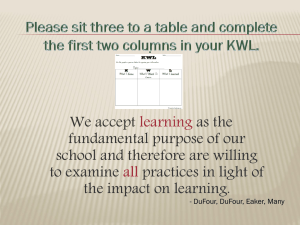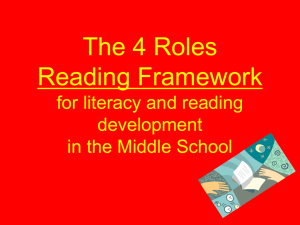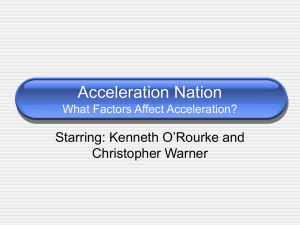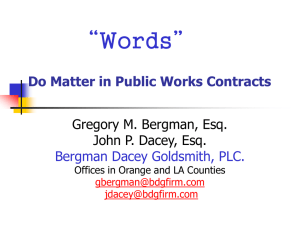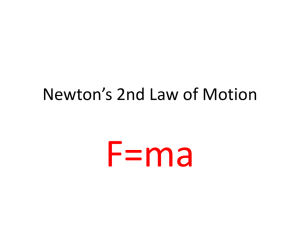Learning Goal
advertisement
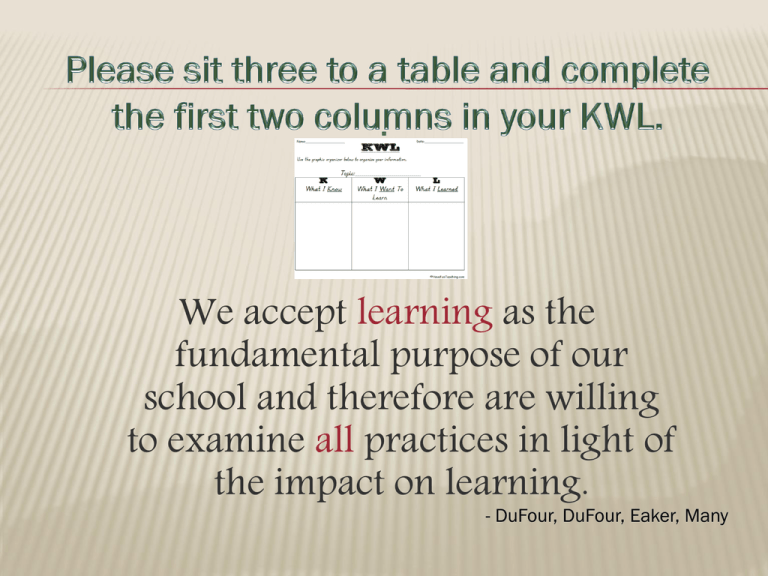
. We accept learning as the fundamental purpose of our school and therefore are willing to examine all practices in light of the impact on learning. - DuFour, DuFour, Eaker, Many . We are committed to working together to achieve our collective purpose. We cultivate a collaborative culture through development of high-performing teams. - DuFour, DuFour, Eaker, Many We assess our effectiveness on the basis of results rather than intentions. Individuals, teams, and schools seek relevant data and information, and use that information to promote continuous improvement. - DuFour, DuFour, Eaker, Many GROUP NORMS Are Respectful of Other’s Opinions and Listen with an Open Mind; Limit the Use of Electronics for Breaks Collaborate in Group Work Take Responsibility for Engaging in Learning and Continuous Growth It’s Okay to have Fun! Suffering is Optional. TODAY’S LEARNING GOAL Participants will be able to develop a scale for tracking student progress towards achieving a learning goal. TELL US WHAT YOU KNOW AND KWL… http://www.havefunteaching.com/worksheets/graphic-organizers/kwl-kwhl/kwl-graphic-organizer-landscape.pdf SELF-ASSESSMENT Participants will be able to develop and use a scale to track student progress toward achieving the learning goal. 0 I know nothing about this learning goal. 1 I really don’t understand what is included in a scale, I might be able write a goal and start a scale with some help. 2 I understand the parts of a scale and can communicate a learning goal but don’t think I can construct a scale by myself. 3 I can construct and use a scale to track student progress toward achieving the learning goal. 4 In addition to constructing and using a scale, I can design formative assessments to evaluate student performance at each of the scale scores. TRACKING MY PROGRESS Participants will be able to develop and use a scale to track student progress toward achieving the learning goal. MarzanoResearch.com Four Critical Questions that Define the Work of a PLC 1 2 What is it we expect our students to learn? How will we know when students have learned? ? 3 How will we respond when students have NOT learned? 4 How will we respond when students have learned? - DuFour, DuFour, Eaker, Many CLASS BUILDING DANCE PARTNERS DANCE CARD What Marzano’s research says High Probability Strategies - Marzano Research Laboratory LEARNING CONTINUUM SCALE A Scale is an attempt to create a continuum that articulates distinct levels of knowledge and skill relative to a specific topic. It can be thought of as an applied version of a learning progression. A well written scale should make it easy for teachers to design and score assessment tasks that can be used to generate both formative and summative scores. - Dr. Robert Marzano Courtesy: Hamilton Elementary 1st Grade Team Source: MarzanoResearch.com Learning Goal: Participant will be able to develop and use a scale to track student progress toward achieving Score: the learning goal. 4.0 3.5 3.0 2.5 2.0 1.5 1.0 0.5 0.0 SEMINOLE COUNTY PUBLIC SCHOOLS Learning Goal: Participant will be able to develop and use a scale to track student progress toward achieving Score: the learning goal. 4.0 3.5 3.0 Participant will construct a scale to track student progress toward achieving a learning goal. Scales should: be related to the learning goal articulate the levels of performance using the taxonomy be written in student language provide consistent feedback to students encourage students to improve. No major errors or omissions regarding the score 3.0 content 2.5 2.0 1.5 1.0 0.5 0.0 SEMINOLE COUNTY PUBLIC SCHOOLS Learning Goal: Participant will be able to develop and use a scale to track student progress toward achieving Score: the learning goal. 4.0 3.5 3.0 Participant will construct a scale to track student progress toward achieving a learning goal. Scales should: be related to the learning goal articulate the levels of performance using the taxonomy be written in student language provide consistent feedback to students encourage students to improve. No major errors or omissions regarding the score 3.0 content 2.5 2.0 Participant recognizes and describes specific terminology such as: Learning Continuum Target Learning Goal Simpler Content More Complex Content No major errors or omissions regarding the score 2.0 content 1.5 1.0 0.5 0.0 SEMINOLE COUNTY PUBLIC SCHOOLS Learning Goal: Participant will be able to develop and use a scale to track student progress toward achieving Score: the learning goal. 4.0 3.5 3.0 Participant will construct a scale to track student progress toward achieving a learning goal. Scales should: be related to the learning goal articulate the levels of performance using the taxonomy be written in student language provide consistent feedback to students encourage students to improve. No major errors or omissions regarding the score 3.0 content 2.5 2.0 Participant recognizes and describes specific terminology such as: Learning Continuum Target Learning Goal Simpler Content More Complex Content Participant is able to communicate a clear learning goal. Goal is a statement of what a student will know or be able to do. Goal is not written as an activity or assignment. Goal supports the standards/benchmark for the course. No major errors or omissions regarding the score 2.0 content 1.5 1.0 0.5 0.0 SEMINOLE COUNTY PUBLIC SCHOOLS Learning Goal: Participant will be able to develop and use a scale to track student progress toward achieving Score: the learning goal. 4.0 Participant will design unobtrusive and obtrusive assessments to evaluate 2.0, 3.0, & 4.0 student performances. No major errors or omissions regarding the score 4.0 content 3.5 3.0 Participant will construct a scale to track student progress toward achieving a learning goal. Scales should: be related to the learning goal articulate the levels of performance using the taxonomy be written in student language provide consistent feedback to students encourage students to improve. No major errors or omissions regarding the score 3.0 content 2.5 2.0 Participant recognizes and describes specific terminology such as: Learning Continuum Target Learning Goal Simpler Content More Complex Content Participant is able to communicate a clear learning goal. Goal is a statement of what a student will know or be able to do. Goal is not written as an activity or assignment. Goal supports the standards/benchmark for the course. No major errors or omissions regarding the score 2.0 content 1.5 1.0 0.5 0.0 SEMINOLE COUNTY PUBLIC SCHOOLS Learning Goal: Participant will be able to develop and use a scale to track student progress toward achieving Score: the learning goal. 4.0 3.5 In addition to score 3.0 performance, in-depth inferences and applications with partial success 3.0 2.5 No major errors or omissions regarding 2.0 content and partial knowledge of the 3.0 content 2.0 1.5 Partial knowledge of the score 2.0 content, but major errors or omissions regarding score 3.0 content 1.0 With help, a partial understanding of some of the simpler details and processes and some of the more complex ideas and processes. 0.5 With help, a partial understanding of the score 2.0 content, but not the score 3.0 content 0.0 Even with help, no understanding or skill demonstrated SEMINOLE COUNTY PUBLIC SCHOOLS Learning Goal: Participant will be able to develop and use a scale to track student progress toward achieving Score: the learning goal. 4.0 Participant will design unobtrusive and obtrusive assessments to evaluate 2.0, 3.0, & 4.0 student performances. No major errors or omissions regarding the score 4.0 content 3.5 In addition to score 3.0 performance, in-depth inferences and applications with partial success 3.0 Participant will construct a scale to track student progress toward achieving a learning goal. Scales should: be related to the learning goal articulate the levels of performance using the taxonomy be written in student language provide consistent feedback to students encourage students to improve. No major errors or omissions regarding the score 3.0 content 2.5 No major errors or omissions regarding 2.0 content and partial knowledge of the 3.0 content 2.0 Participant recognizes and describes specific terminology such as: Learning Continuum Target Learning Goal Simpler Content More Complex Content Participant is able to communicate a clear learning goal. Goal is a statement of what a student will know or be able to do. Goal is not written as an activity or assignment. Goal supports the standards/benchmark for the course. No major errors or omissions regarding the score 2.0 content 1.5 Partial knowledge of the score 2.0 content, but major errors or omissions regarding score 3.0 content 1.0 With help, a partial understanding of some of the simpler details and processes and some of the more complex ideas and processes. 0.5 With help, a partial understanding of the score 2.0 content, but not the score 3.0 content 0.0 Even with help, no understanding or skill demonstrated SEMINOLE COUNTY PUBLIC SCHOOLS Four Critical Questions that Define the Work of a PLC 1 2 What is it we expect our students to learn? How will we know when students have learned? ? 3 How will we respond when students have NOT learned? 4 How will we respond when students have learned? - DuFour, DuFour, Eaker, Many LEARNING GOALS CHART MAKE A DISTINCTION BETWEEN LEARNING GOALS AND LEARNING ACTIVITIES OR ASSIGNMENTS A learning goal identifies what students will learn or be able to do as a result of instruction, separate from what they do to demonstrate the learning. Learning activities and assignments help students reach learning goals. LEARNING GOALS, ACTIVITIES & ASSIGNMENTS: EXAMPLE Subject Learning Goal Activity Assignment Physics Students will be able to analyze the motion of an object in terms of its position, velocity, and acceleration (with respect to a frame of reference) as functions of time. Students will watch a video that demonstrates the relationship between velocity, distance, acceleration, and time. Students will design, construct, and launch a water bottle rocket with small groups to assess understanding. Read pp 647-682 and complete a graphic organizer and the chapter review questions. TRACKING MY PROGRESS Participants will be able to develop and use a scale to track student progress toward achieving the learning goal. MarzanoResearch.com Four Critical Questions that Define the Work of a PLC 1 2 What is it we expect our students to learn? How will we know when students have learned? ? 3 How will we respond when students have NOT learned? 4 How will we respond when students have learned? - DuFour, DuFour, Eaker, Many SCALES AND THE USE OF FEEDBACK If •goals provide clear targets for learning Then •feedback facilitates the process of reaching those targets. SCALE NON-EXAMPLE Why is this not an example of a scale or rubric? Learning Goal: Students will be able to analyze the motion of an object in terms of its position, velocity, and acceleration (with respect to a frame of reference) as functions of time. Water Bottle Rocket Lab Possible Points Creativity 15 Listening/Following Directions Outside 10 Followed Criteria 10 Team Effort 10 Launched 15 Time-of-Flight is a minimum of 3 Seconds 20 Calculations 20 Score DEVELOPING SCALES In depth understanding of the Learning Goal Declarative/Procedural Knowledge Requires Strategic and Extended Thinking Articulation of a logical continuum of thinking Foundational Knowledge to Critical Thinking Taxonomies: Webb’s, Bloom’s, Marzano’s Opportunity for students to extend thinking Score 4.0 on the scale MARZANO’S GENERIC SCALE Organize Learning Goals into a Scale • Advanced = 4.0 More Complex Content • Proficient = 3.0 Target Learning Goal (Complex Content) • Progressing = 2.0 Simpler Content Development of a Scale for Student Learning: Example Student Learning Goal: Students will be able to analyze the motion of an object in terms of its position, velocity, and acceleration (with respect to a frame of reference) as functions of time. Scale Score 4.0 Comments The student will be able to predict the effect of design changes on position, velocity, and acceleration of an object in motion. Score 3.0 Score 2.0 The student will: - define velocity, acceleration, gravity, change in velocity - understand the effect of force on an object in motion Score 1.0 With help, partial success Score 0.0 Even with help, no success EXERCISE 3.1 Simpler and More Complex Content for Learning Goals http://www.marzanoresearch.com/reproducibles/designing_teaching.aspx#reproducibles DANCE PARTNERS In addition to Score 3.0, in-depth inferences and applications that go beyond instruction to the standard The student will: 4.0 No major errors or omissions regarding the score 4.0 content 3.5 In addition to score 3.0 performance, in-depth inferences and applications with partial success The student will: 3.0 No major errors or omissions regarding the score 3.0 content (simple or complex) 2.5 No major errors or omissions regarding 2.0 content and partial knowledge of the 3.0 content The student recognizes and describes specific terminology such as: 2.0 The student will: No major errors or omissions regarding the simpler details and processes but major errors or omissions regarding the more complex ideas and processes 1.5 1.0 With help, a partial understanding of some of the simpler details and processes and some of the more complex ideas and processes. 0.5 0.0 Partial knowledge of the score 2.0 content, but major errors or omissions regarding score 3.0 content With help, a partial understanding of the score 2.0 content, but not the score 3.0 content Even with help, no understanding or skill demonstrated USING THE TAXONOMY Learning Goal: Participant will be able to develop and use a scale to track student progress toward achieving Score: the learning goal. 4.0 Participant will design unobtrusive and obtrusive assessments to evaluate 2.0, 3.0, & 4.0 student performances. No major errors or omissions regarding the score 4.0 content 3.5 In addition to score 3.0 performance, in-depth inferences and applications with partial success 3.0 Participant will construct and use a scale to track student progress toward achieving the learning goal. Scales should: be related to the learning goal articulate the levels of performance using the taxonomy be written in student language provide consistent feedback to students encourage students to improve. No major errors or omissions regarding the score 3.0 content 2.5 No major errors or omissions regarding 2.0 content and partial knowledge of the 3.0 content 2.0 Participant recognizes and describes specific terminology such as: Learning Continuum Target Learning Goal Simpler Content More Complex Content Participant is able to communicate a clear learning goal. Goal is a statement of what a student will know or be able to do. Goal is not written as an activity or assignment. Goal supports the standards/benchmark for the course. No major errors or omissions regarding the score 2.0 content 1.5 Partial knowledge of the score 2.0 content, but major errors or omissions regarding score 3.0 content 1.0 With help, a partial understanding of some of the simpler details and processes and some of the more complex ideas and processes. 0.5 With help, a partial understanding of the score 2.0 content, but not the score 3.0 content 0.0 Even with help, no understanding or skill demonstrated SEMINOLE COUNTY PUBLIC SCHOOLS TRACKING MY PROGRESS Participants will be able to develop and use a scale to track student progress toward achieving the learning goal. MarzanoResearch.com SCALE DEVELOPMENT FOR STUDENT LEARNING In addition to Score 3.0, in-depth inferences and applications that go beyond instruction to the standard The student will: 4.0 • • No major errors or omissions regarding the score 4.0 content 3.5 In addition to score 3.0 performance, in-depth inferences and applications with partial success The student will: • 3.0 o o o No major errors or omissions regarding the score 3.0 content (simple or complex) 2.5 No major errors or omissions regarding 2.0 content and partial knowledge of the 3.0 content The student recognizes and describes specific terminology such as: 2.0 • • • • The student will: • • • No major errors or omissions regarding the simpler details and processes but major errors or omissions regarding the more complex ideas and processes 1.5 1.0 With help, a partial understanding of some of the simpler details and processes and some of the more complex ideas and processes. 0.5 0.0 Partial knowledge of the score 2.0 content, but major errors or omissions regarding score 3.0 content With help, a partial understanding of the score 2.0 content, but not the score 3.0 content Even with help, no understanding or skill demonstrated In addition to Score 3.0, in-depth inferences and applications that go beyond instruction to the standard The student will: 4.0 • • No major errors or omissions regarding the score 4.0 content 3.5 In addition to score 3.0 performance, in-depth inferences and applications with partial success The student will: 3.0 • analyze the motion of an object in terms of its position, velocity, and acceleration (with respect to a frame of reference) as functions of time. o o o No major errors or omissions regarding the score 3.0 content (simple or complex) 2.5 No major errors or omissions regarding 2.0 content and partial knowledge of the 3.0 content The student recognizes and describes specific terminology such as: 2.0 • • • • The student will: • • • No major errors or omissions regarding the simpler details and processes but major errors or omissions regarding the more complex ideas and processes 1.5 1.0 With help, a partial understanding of some of the simpler details and processes and some of the more complex ideas and processes. 0.5 0.0 Partial knowledge of the score 2.0 content, but major errors or omissions regarding score 3.0 content With help, a partial understanding of the score 2.0 content, but not the score 3.0 content Even with help, no understanding or skill demonstrated In addition to Score 3.0, in-depth inferences and applications that go beyond instruction to the standard The student will: 4.0 • • No major errors or omissions regarding the score 4.0 content 3.5 In addition to score 3.0 performance, in-depth inferences and applications with partial success The student will: 3.0 • analyze the motion of an object in terms of its position, velocity, and acceleration (with respect to a frame of reference) as functions of time. o calculate change in velocity, acceleration, position as a function of time o attend to meaning of quantities (not just how to compute) o attend to precision No major errors or omissions regarding the score 3.0 content (simple or complex) 2.5 No major errors or omissions regarding 2.0 content and partial knowledge of the 3.0 content The student recognizes and describes specific terminology such as: 2.0 • • • • The student will: • • • No major errors or omissions regarding the simpler details and processes but major errors or omissions regarding the more complex ideas and processes 1.5 1.0 With help, a partial understanding of some of the simpler details and processes and some of the more complex ideas and processes. 0.5 0.0 Partial knowledge of the score 2.0 content, but major errors or omissions regarding score 3.0 content With help, a partial understanding of the score 2.0 content, but not the score 3.0 content Even with help, no understanding or skill demonstrated In addition to Score 3.0, in-depth inferences and applications that go beyond instruction to the standard The student will: 4.0 • • No major errors or omissions regarding the score 4.0 content 3.5 In addition to score 3.0 performance, in-depth inferences and applications with partial success The student will: 3.0 • analyze the motion of an object in terms of its position, velocity, and acceleration (with respect to a frame of reference) as functions of time. o calculate change in velocity, acceleration, position as a function of time o attend to meaning of quantities (not just how to compute) o attend to precision No major errors or omissions regarding the score 3.0 content (simple or complex) 2.5 No major errors or omissions regarding 2.0 content and partial knowledge of the 3.0 content The student recognizes and describes specific terminology such as: 2.0 • • • • velocity acceleration position frame of reference The student will: • • • No major errors or omissions regarding the simpler details and processes but major errors or omissions regarding the more complex ideas and processes 1.5 1.0 With help, a partial understanding of some of the simpler details and processes and some of the more complex ideas and processes. 0.5 0.0 Partial knowledge of the score 2.0 content, but major errors or omissions regarding score 3.0 content With help, a partial understanding of the score 2.0 content, but not the score 3.0 content Even with help, no understanding or skill demonstrated In addition to Score 3.0, in-depth inferences and applications that go beyond instruction to the standard The student will: 4.0 • • No major errors or omissions regarding the score 4.0 content 3.5 In addition to score 3.0 performance, in-depth inferences and applications with partial success The student will: 3.0 • analyze the motion of an object in terms of its position, velocity, and acceleration (with respect to a frame of reference) as functions of time. o calculate change in velocity, acceleration, position as a function of time o attend to meaning of quantities (not just how to compute) o attend to precision No major errors or omissions regarding the score 3.0 content (simple or complex) 2.5 No major errors or omissions regarding 2.0 content and partial knowledge of the 3.0 content The student recognizes and describes specific terminology such as: 2.0 • • • • velocity acceleration position frame of reference The student will: • describe an object’s motion • understand the effect of force on an object in motion • calculate speed No major errors or omissions regarding the simpler details and processes but major errors or omissions regarding the more complex ideas and processes 1.5 1.0 With help, a partial understanding of some of the simpler details and processes and some of the more complex ideas and processes. 0.5 0.0 Partial knowledge of the score 2.0 content, but major errors or omissions regarding score 3.0 content With help, a partial understanding of the score 2.0 content, but not the score 3.0 content Even with help, no understanding or skill demonstrated In addition to Score 3.0, in-depth inferences and applications that go beyond instruction to the standard The student will: 4.0 • evaluate design changes and predict the effect of these changes on position, velocity, and acceleration of an object in motion. No major errors or omissions regarding the score 4.0 content 3.5 In addition to score 3.0 performance, in-depth inferences and applications with partial success The student will: 3.0 • analyze the motion of an object in terms of its position, velocity, and acceleration (with respect to a frame of reference) as functions of time. o calculate change in velocity, acceleration, position as a function of time o attend to meaning of quantities (not just how to compute) o attend to precision No major errors or omissions regarding the score 3.0 content (simple or complex) 2.5 No major errors or omissions regarding 2.0 content and partial knowledge of the 3.0 content The student recognizes and describes specific terminology such as: 2.0 • • • • velocity acceleration position frame of reference The student will: • describe an object’s motion • understand the effect of force on an object in motion • calculate speed No major errors or omissions regarding the simpler details and processes but major errors or omissions regarding the more complex ideas and processes 1.5 1.0 With help, a partial understanding of some of the simpler details and processes and some of the more complex ideas and processes. 0.5 0.0 Partial knowledge of the score 2.0 content, but major errors or omissions regarding score 3.0 content With help, a partial understanding of the score 2.0 content, but not the score 3.0 content Even with help, no understanding or skill demonstrated Tracking Student Progress “Two strategies seem especially promising for schools. One is to expand the quality and variety of formative assessments; a second is to promote and organize collective inquiry into and discussion of student progress and achievement based on a range of assessments.” —Judith Warren Little, (2006) p. 9.Why Common Formative Assessments? WWW.MARZANORESEARCH.COM DEVELOP A SCALE FOR YOUR LEARNING GOAL Start with Score 3.0 and write your Target Learning Goal Continue to develop Score 2.0 and Score 4.0 Include specific indicators that would demonstrate acceptable performance for that score. Scale Comments Score 4.0 Inferential Understanding (Beyond Standards) More Complex Content Score 3.0 Essential Complex Content (Based on the Standards) Target Learning Goal Score 2.0 Essential Foundational Knowledge Simpler Content SHARE YOUR RESULTS Combine two PLCs Share your scale Each member of the host PLC will ask questions and provide constructive feedback. Revise your scale, if necessary. TRACKING MY PROGRESS Participants will be able to develop and use a scale to track student progress toward achieving the learning goal. MarzanoResearch.com LAST DANCE The Most Powerful Strategy for Improving Student Learning: Teachers work together in collaborative teams Clarify what students must learn. Analyze that evidence & determine how to respond. Gather evidence of student learning. Identify the most powerful teaching strategies. “Reflective teaching must be based on evidence of student learning, and reflection is most powerful when it is collaborative.” (John Hattie, 2009) Tracking Student Progress “Two strategies seem especially promising for schools. One is to expand the quality and variety of formative assessments; a second is to promote and organize collective inquiry into and discussion of student progress and achievement based on a range of assessments.” —Judith Warren Little, (2006) p. 9.Why Common Formative Assessments?

